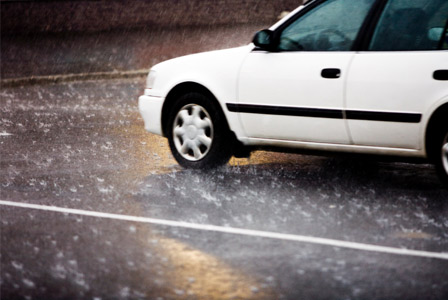Clik here to view.

What would you do if your tires hit water and you lost all control of steering and braking? Take precautions and make sure you never find yourself in this dangerous situation.
Avoid hydroplaning
Maintain your tires
If skidding across a wet road into oncoming traffic isn't your idea of a good time, make sure your tires are maintained. Hydroplaning, or aquaplaning, occurs when a vehicle loses traction due to a layer of water coming between the wheels and the road. What can you do to keep those wheels on the ground? Make sure the treads of your tires aren't worn down, and always keep tires inflated according to manufacturer-recommended levels. "The U.S. minimum legal depth is 3/32 of an inch," says Eddie Wren, president and chief instructor, Advanced Drivers of America, "but if you live in an area that gets frequent heavy rain, 3/16 of an inch would be wiser and significantly safer."Watch your speed
Speeding on slick, rain-soaked roads is a recipe for disaster. It can certainly be tempting to rush to your destination, but speeding on wet roads is the number one cause of hydroplaning, so slow down! Your tires need time to push the water out of the way for a safe drive. "The most important cause is driving too fast for the circumstances," says Wren, "so when it is raining hard or there is standing water on the road, by far the most important way to deal with hydroplaning is to slow down before it happens."
Turn off cruise control
If the roads are wet, or if you spot even a drop of rain on the windshield, turn off cruise control immediately. The last thing you want to experience is your wheels continuing to spin at the same rate while skidding across a slick pool of water. You also don't want to have to slam on the brakes to disengage cruise control in a hydroplane. The results could be deadly.
Go through puddles slowly
Yes, splashing through puddles can be fun — just not in your car. Proceed with caution through standing water. Scan the area ahead of you and watch for big splashes coming off the wheels of other vehicles. If you see a splash, gradually reduce your speed. Remember, hydroplaning can occur at water depths of just one-tenth of an inch.
Stay calm
If you find yourself in a hydroplane, don't panic. You should regain control once your tires come back into contact with the road. "The only thing a driver can do when hydroplaning is straighten the wheels so that when they regain grip on less-wet ground the car will not slew hard to one side," says Wren. "It is wise not to hit the brakes, either, until road grip is regained."
Image may be NSFW.
Clik here to view. Expert Tip:
Expert Tip:
"If you live in a place that gets regular flash floods, or where there's particularly poor drainage, you might consider buying tires that are specially designed for their resistance to hydroplaning. Two that we know of are the Michelin HydroEdge and the Goodyear Assurance TripleTread."
— Tom and Ray, Car Talk
More safe driving tips
10 Ways to avoid an accident
The how and why of rollovers
How to recover from a skid